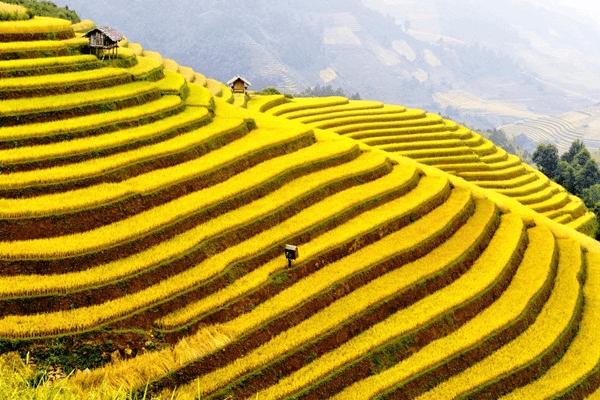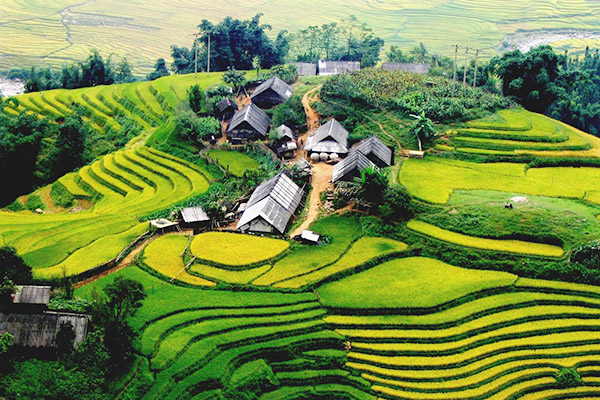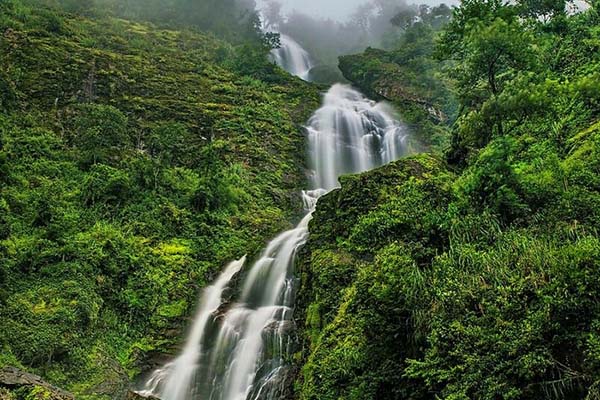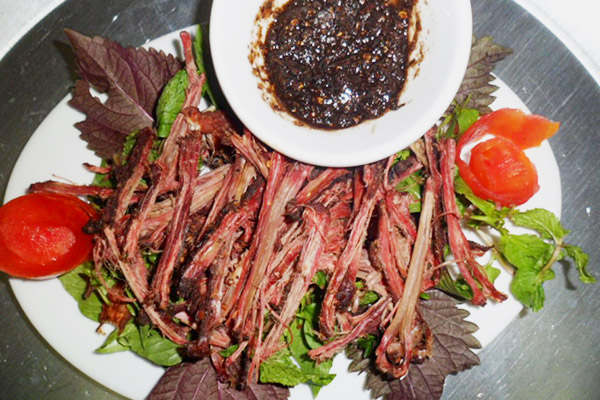Sapa is one of Vietnam’s most famous and most northern trekking destinations. Because tourists will enjoy stunning rice terraces, the colder temperatures, the culture, traditional batik handicrafts of ethnic monitories and a magical overnight train to get there. This amazing place has the breathtaking landscape of terraced rice fields under the country’s highest peak Mount Fansipan-the roof of Indochina, and blazing green fields cut by fast-flowing streams.
The best of North Vietnam is spending holidays on traveling to Sapa in order to get the awesome feeling in the trip
The highlights of Sapa tour:
- Getting to Sapa from Hanoi by sleeper bus or train
- Enjoying many the natural beauty and magnificent landscapes of Muong Hoa valley and Silver water
- Visiting several villages of ethnic minorities in Sapa such as Cat Cat, Ta Van, and Giang Ta Chai
- Conquering the top of Fansipan Peak called the Roof of Indochina
- Discovering the atmosphere at Bac Ha market – the largest market in the region
- Enjoying almost the traditional foods in the ethnic groups
Best time to visit
Thanks to its high altitude, Sapa is an ideal location for summer retreat during the overheated summertime and the scarcely populated town also has pretty fresh air. The warmest months are July and August with the average temperature is 29.4ºC, and the coldest months are December and January is 10ºC. While trips can be enjoyed year-round, the winters in Sapa get cold, with some fog and drizzle, and snow falls in some years on the highest peaks.
The four seasons are distinctly felt in Sapa when Nature changes her costume. Spring is bright with pear, peach, apricot and plum flowers. Summer comes blooming with many fruits. Autumn is the time for perfume mushrooms, wood ears and plenty of specious medicinal plants… The sky is the vividly brightened with golden sun-rays and playful white clouds which seem to land on the ground, over the heads of people or on tops of trees. In winter, fog filled the space, making the landscapes look more mystery and attractive.
Sapa also experiences a marked wet season from May to September, with the heaviest rainfall occurring in July and August. The weather is notorious for changing frequently and quickly. If you visit Sapa in summer, you can feel the climate of four seasons in one day. For distance, in the morning and afternoon, it is cool like the weather of spring and autumn. At noon, it is as sunny and cloudless as the weather of summer. And it is cold in the evening. For the most pleasant weather, the best time to visit Sapa is March and May or mid-September to early December because, in this period, the ethnic people grow rice on terraced fields which has its color changed seasonally and charming beauty.
In September and October, the terraced rice fields look like golden silk scarves flying over in the wind above green mountain slopes, making the mountainous landscape amazingly beautiful.
From late December to February, Sapa has a harsh winter with temperature sometimes drops to below zero degree and tree branches and grass are covered with ice. Sapa on icy days always attracts many tourists and photographers and strangely all the most beautiful pictures about Sapa are taken in wintertime. Moreover, traveling to Sapa at this time, visitors may contemplate beauty-spot as breathtaking as in picture described in the Snow Queen fairy tale of Andersen.
Cat Cat village
Cat Cat village is located at the foot of Fansipan Peak and situated in a beautiful valley about three kilometers from Sapa Town. This village is the home of the Black H’mong. This village is appeared for a long time, which attracts tourists from all by its distinctive customs and practices. This is a village of Black H’mong people where you can discover many interesting facts about their daily life as well as culture and architecture. Thus, you should choose the several traditional handicrafts from the craftsmen such as twisting flax and weaving fabric to hold. Then you will know the color of traditional clothes made by women.
Lao Chai village and Ta Van village
You can continue hiking downhill with the next destination is Lao Chai village which is the best of North Vietnam. Easily accessed by many advantageous trekking routes, this hill-tribe village can be checked in within 3 hours for a medium trekker. Lao Chai is the settlement of Black H’Mong ethnic people. Trekking here, you can enjoy the fresh air, feast your eyes on the wonderful natural scenery of the beautiful green terraces, the endless mountain ranges, the hidden ethnic houses. Standing on Lao Chai, you will admire a spectacular view of Hoang Lien Mountains, Ham Rong mountain, and the lush terraced fields. Hiking through the village, you can have a good opportunity to learn more about the H’mong culture, discover the special handicrafts, their traditional clothes, indigo …
Next, you hike from Lao Chai to Tavan. The trail connecting the two villages is quite small so you need to trek one by one. Along the two sides, there is an appealing panorama of a fertilizing terraced field adorned by the verdurous hue of corn and rice. Most ethnic Giay in Ta Van live together with growing rice as their major earning jobs Besides, they also can engrave silver and instruments. You shouldn’t miss this village because it offers the great experience for you to learn more about the culture and customs of this place. Naturally, the unique civilization and honorable values inside Giay characteristic and soul will convincingly be kept as the most impressive feature in your travel book.
Muong Hoa Valley
you will spend the whole day exploring the spectacular Muong Hoa, famed as the most beautiful valley in the region. You will follow to the only road built on the side of a mountain range in order to look down the valley and admire the view of magnificent landscapes composed of high mountains, and a stream of water winding and terraced rice paddies… Many time, leaving the main road, you will visit tribal villages such as Ta Van of the Zay people…there are chances for meeting and contacting locals at home and it works.
Ham Rong mountain peak
In Geography, Ham Rong Mountain is located nearly to Sapa town center, which is one of the places in Sapa trekking guide. Thus, it is easy to get it. One suggestion for you is to bring the devices, camera to take the photograph when walking at leisure to the top of this mountain just to relax while looking at scenic surroundings. The site has been restructured with typical natural landscape and resting station for climbers. Catching up Ham Rong peak is not waste your energy as you think, on the contrary, this peak is very easy to top as its path is not so steep. Continuously, you keep the walking to grace panoramic view of the whole Sapa town might make one’s heart beat faster. Muong Hoa valley and villages of ethnic people have created an amazing picture of nature.
Fansipan
Catching up the top of Fansipan Peak called the Roof of Indochina is the most challenging level for trekkers. Thus, you will need to spend two days and one night finishing the hike. You can’t trek by yourself as the dangerous so you need a local experienced guide and porter who brings your luggage as well as understand the route deeply. After passing Cat Cat village and crossing Muong Hoa River, you need to trek upward for nearly 7 hours to reach the first campsite at a height of 2300 meters. After passing the first step, you will take challenges in the next step with hiking since you trek through the arrowroot plantations and bamboo forests. To save your energy, you should overnight in the tent on the mountain slope facing west, near a mountain stream. On the next day, you will conquer to the peak of Fansipan Peak, with the height of 3143 meters. After a difficult climb maybe three hours to pass the dense bamboo forest, the climbers are rewarded with the magnificent wild green nature with blue sky and a sea of clouds around the mountain. Standing on the peak of Fansipan is an amazing and victorious feeling. Do not forget to take pictures from different directions because this might be a once-in-a-lifetime moment.
Bac Ha market
Bac Ha market located in Bac Ha district, which is one of the largest markets in Lao Cai province and is the best of North Vietnam. This market is organized every Sunday and it is famous for the originality and authenticity that the traders still preserve.
Bac Ha market is not simply a place for exchanging goods but also a chance for people from different ethnicities to come and meet. You also admire almost women demonstrate on their beautiful handmade traditional costumes and even for youngsters to find their dates. To approach the Sunday market, many ethnic vendors must walk long distance passing mountains and hills even so far.
The market is separated into many squares where trade a lot of products such as handicrafts, food, horse, poultry, and blacksmith. Moreover, you should enjoy the traditional foods in the ethnic groups. Each has its own trait and worth joining. You are free to take unique photos.
One suggestion for you is to try “thang co” blood porridge, a popular dish of the H’Mong and other local people. Thang Co is a type of soup which is made of horsemeat, horse’s viscera and horse’s bone. Cap Nach pork is a specialty of this mountainous region. The ways to make this dish is diverse. We ensure that you like very much the meat as a whole pig roast directly on charcoal so that the skin covering the pork is very brittle. Under the suitable temperature, it is the good environment for salmon to exist. Grilled skewers are the most famous delicacy of Sapa since tourists all come to enjoy the hot and tasty barbecue with many different local ingredients in the middle of the typical cool weather of Sapa.





